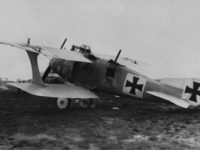The Roland C.II aircraft were not only the smallest used on the German side two-seater of the First World War, it was also the first aircraft whose development was based on the findings of a test in the wind tunnel and, accordingly, the aircraft were particularly aerodynamically designed.
Development and construction:
After the development of the prototype Roland C.I began 1915 under the direction of Professor Ludwig Prandtl for the first time the development of an airplane with the results of a wind tunnel attempt. This was carried out in the aerodynamic research institute in Göttingen and served the construction of streamlined hulls and wings, which should improve on the one hand the speed and on the other hand the stability of airplanes. Due to the results, it was also possible to build the aircraft very small, so this offered the smallest attack surface for enemy shooters.
Through these tests, the company Luftfahrzeug-Gesellschaft m.b.H. with the Roland C.II deliver the most aerodynamically constructed aircraft to the German army.
The aircraft was equipped with a 160PS Mercedes D III engine. Although there were engines that had a higher horsepower at this time, in contrast to the D III, these were not yet mature enough. In arming a swiveling parabellum machine gun 14 was installed for the observer. In the first series of the aircraft, the pilot had no machine gun, only with the second series was mounted on the C.II the 08/15 Spandau machine gun.
After the production of C.II had begun, work was already on a successor model. The Roland C.III had eight braces between the wings instead of two large I-stems and was equipped with the 200PS Benz Bz IV engine. However, the C.III prototype was destroyed in a factory fire.
Use in the First World War:
From March 1916, the first aircraft of the type Roland C.II were brought to the front and were able to oppose by their flight characteristics most Allied aircraft.
The biggest drawback of the aircraft, however, proved in the bad view of the pilot down which made landings difficult. Thus, it was not uncommon for serious accidents on landing.
From the spring of 1917, the departure of aircraft from the fronts was begun to replace them with stronger models. Until the end of the war, these served as training aircraft or were sold to the Allied states.
Overall, the Roland C.II produced around 300 aircraft.
Technical specifications:
| Designation: | L.F.G. Roland C.II |
| Country: | German Empire |
| Typ: | Armed reconnaissance aircraft |
| Length: | 7,7 meters |
| Span: | 10,33 meters |
| Height: | 2,9 meters |
| Mass: | 789kg empty |
| Crew: | Max. 2 |
| Engine: | water-cooled six-cylinder in-line engine Mercedes D III with 160hp |
| Maximum speed: | 165 km/h |
| Reach: | unknown |
| Armament: | 1 machine gun 7,92 mm Parabellum, 1 x 7,92 mm 08/15 Spandau machine gun and up to 4 x 12.5Kg bombs |
You can find the right literature here:
Fokker Dr I Aces of World War 1 (Aircraft of the Aces)
Undoubtedly the most famous fighter type to see service on either side during World War 1, the Fokker Dr I was a revelation when it entered service on the western front in 1917. Manfred von Richthofens JG 1 circus was the first Jasta to completely re-equip with the new fighter, and in the skilled hands of its numerous aces the Dr I proved a formidable opponent. The Dr I remained in service on the Western Front until replaced by the superior Fokker D VII in May 1918. Just weeks prior to that, however, Germanys leading ace, the great Red Baron, had been killed at the controls of a Dr I.
Friedrichshafen Aircraft of WWI: A Centennial Perspective on Great War Airplanes (Great War Aviation) (Volume 21)

Friedrichshafen Aircraft of WWI: A Centennial Perspective on Great War Airplanes (Great War Aviation) (Volume 21) Paperback – February 16, 2016
This book describes and illustrates the development of Friedrichshafen aircraft of WWI with text, 540 photos, 18 in color, 37 color profiles, production quantities and serial numbers of aircraft, and aircraft dimensions and performance specifications. In addition, there are 26 official SVK drawings and 11 aircraft are illustrated in scale drawings to 1/48 (4) or 1/72 (7) scales. The book has 312 pages and is of interest to aviation historians, enthusiasts, and modelers alike.
German and Austro-Hungarian Aircraft Manufacturers 1908-1918
Much has been written about the British aircraft of the First World War, but little has surfaced about the aircraft of the Axis powers, Germany and Austria. Here, Terry C. Treadwell tells the story of the aircraft from companies such as Fokker, builder of the famous triplane, as fl own by Baron von Richthofen's Flying Circus, AEG, Albatros, Junkers and Hansa. From reconnaissance aircraft to state-of-the-art bombers that could reach London, this is the definitive guide to aircraft of the Axis powers during the First World War. The aircraft are explained in detail and a history of each company is provided, making this an excellent source book for aircraft enthusiasts, model makers and those interested in the air war over the trenches of France and Belgium, as well as further afield in the Italian campaign.
The Zeppelin in Combat: A History of the German Naval Airship Division
The standard reference now revised and expanded. Dr. Robinson has opened up his vast photo archives to enhance this new edition of his classic work. Much of the new photographic material is published here for the first time.
This post is also available in:
 Deutsch (German)
Deutsch (German)  Français (French)
Français (French)  Italiano (Italian)
Italiano (Italian)  简体中文 (Chinese (Simplified))
简体中文 (Chinese (Simplified))  Русский (Russian)
Русский (Russian)  Español (Spanish)
Español (Spanish)  العربية (Arabic)
العربية (Arabic)


















